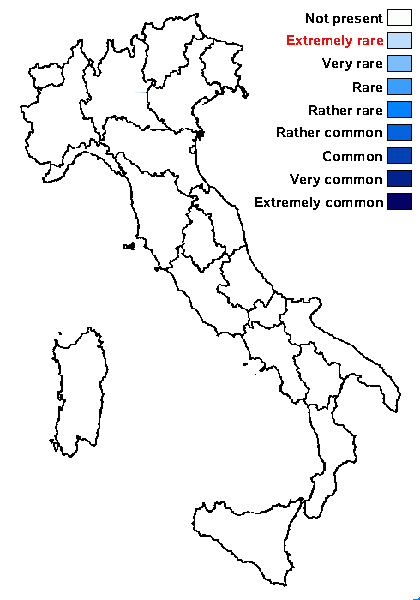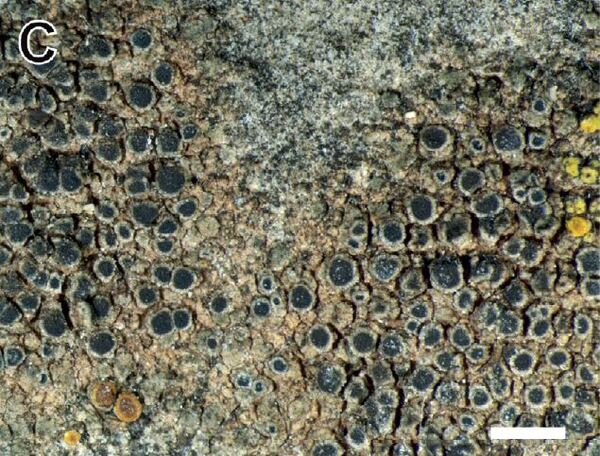Pyrenodesmia micromontana (Frolov, Wilk & Vondrák) Hafellner & Türk
Stapfia, 104, 1: 173, 2016.. Basionym: Caloplaca micromontana Frolov, Wilk & Vondrák - in Frolov & al., Ann. bot. Fenn., 53, 3-4: 255, 2016.
Synonyms:
Distribution:
Description: Thallus crustose, episubstratic, ochre or grey, 95-123(-175) µm thick, of contiguous, angular to rounded, more or less flat areoles, rarely reduced and present only around the apothecia. True cortex not developed, usually substituted by an alveolate cortex of spherical cells with a poorly delimited epinecral layer. Apothecia zeorine or rarely biatorine, (0.22-)0.3-0.4(-0.44) mm across, immersed to adnate, rarely sessile, with a brown to black, rarely white-pruinose disc, a concolorous proper margin, and a poorly developed thalline margin. Exciple 15-75 µm wide, formed of a (8-)16-31(-50) µm wide proper exciple and a 9-11(-30) µm wide, ecorticate thalline exciple with extracellular crystals; upper part of proper exciple of 3.5-7.5 µm wide, thin-walled cells, lower part of palisade prosoplectenchyma; epithecium grey, rarely with a faint brown tinge, K+ violet; hymenium colourless, not inspersed with oil droplets, rarely with crystals, (63-)80-90(-100) µm high. I+ blue; paraphyses mostly simple, (1.5-)2-2.5 (-3) µm thick in lower part, the apical cells (4-)5-6(-7.5) µm wide; hypothecium colourless, inspersed with oil droplets, (55-)80-100(-125) µm high, I+ blue, underlain by an algal layer. Asci 8-spored, clavate, functionally unitunicate, apically thickened with a broad internal beak, the inner part of apex and external cap I+ blue, Teloschistes-type. Ascospores 2-celled, polarilocular, hyaline, ellipsoid, (11-)14-16(-19) x (5.5-)7-9(-10) µm, the equatorial thickening (“septum”) up to 2.5 µm, with a broad cytoplasmatic channel. Pycnidia with a dark grey tip. Conidia ellipsoid, 3-4.5 x 1.5-2 µm. Photobiont chlorococcoid. Spot tests: thallus and apothecia K-, C-, KC-, P-, UV- (but upper parts of thallus, apothecial margins and pycnidial tips may react faintly K+ violet in section). Chemistry: epithecium, thallus, apothecial margin and pycnidial tips with the Sedifolia-grey pigment; anthraquinones absent. Note: on more or less calciferous rocks in upland areas. Never reported from Italy, but known from the Austrian Alps; to be looked for in the Italian Alps.
Growth form: Crustose
Substrata: rocks
Photobiont: green algae other than Trentepohlia
Reproductive strategy: mainly sexual
Commonnes-rarity: (info)
Alpine belt: absent
Subalpine belt: extremely rare
Oromediterranean belt: absent
Montane belt: extremely rare
Submediterranean belt: absent
Padanian area: absent
Humid submediterranean belt: absent
Humid mediterranean belt: absent
Dry mediterranean belt: absent

Predictive model
Growth form: Crustose
Substrata: rocks
Photobiont: green algae other than Trentepohlia
Reproductive strategy: mainly sexual
Commonnes-rarity: (info)
Alpine belt: absent
Subalpine belt: extremely rare
Oromediterranean belt: absent
Montane belt: extremely rare
Submediterranean belt: absent
Padanian area: absent
Humid submediterranean belt: absent
Humid mediterranean belt: absent
Dry mediterranean belt: absent

Predictive model
 Index Fungorum
Index Fungorum
 GBIF
GBIF


